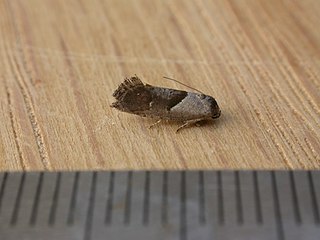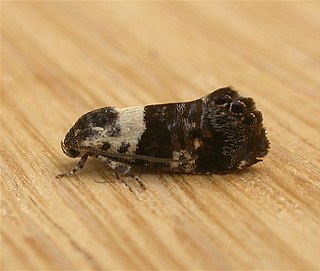
Eupselia holoxantha is a species of moth of the family Depressariidae. It is found in Australia, where it has been recorded from Queensland, New South Wales, the Australian Capital Territory and South Australia.

Eupselia beatella is a species of the family Depressariidae that occurs in Australia, where it has been recorded from Queensland, New South Wales and the Australian Capital Territory.

Eupselia aristonica is a species of moth of the family Depressariidae. It is found in Australia, where it has been recorded from New South Wales, the Australian Capital Territory, Victoria and Tasmania.

The common Eupselia moth, Eupselia carpocapsella, is a species of moth of the family Depressariidae. It is found in Australia, where it has been recorded from New South Wales and South Australia.

Eupselia satrapella is a species of moth of the family Depressariidae. It is found in Australia, where it has been recorded from Queensland, New South Wales and the Australian Capital Territory.

Aulacodes is a genus of moths of the family Crambidae. The genus was first described by Achille Guenée in 1854.
Marasmianympha is a genus of moths of the grass moth family (Crambidae) described by Eugene G. Munroe in 1991. Its single species, Marasmianympha eupselias, was described by Edward Meyrick in 1929. Among the grass moths, it belongs to subfamily Spilomelinae. It is endemic to the Marquesas Islands of Polynesia, where it has been recorded on Fatu Hiva, Hiva Oa and Tahuata, but is suspected to occur on other islands as well. The holotype specimen is in the Natural History Museum, London.
The Hypertrophinae are a subfamily of small moths in the family Depressariidae. The subfamily was described by Thomas Bainbrigge Fletcher in 1929.

Eupselia is a moth genus of the family Depressariidae.

Eupselia metabola is a moth in the family Depressariidae. It was described by Alfred Jefferis Turner in 1947. It is found in Australia, where it has been recorded from Queensland.
Eupselia anommata is a moth in the family Depressariidae. It was described by Alfred Jefferis Turner in 1898. It is found in Australia, where it has been recorded from New South Wales.
Eupselia callidyas is a moth in the family Depressariidae. It was described by Edward Meyrick in 1915. It is found in Australia, where it has been recorded from the Northern Territory.
Eupselia isacta is a moth in the family Depressariidae. It was described by Edward Meyrick in 1910. It is found in southern India.
Eupselia leucaspis is a moth in the family Depressariidae. It was described by Edward Meyrick in 1906. It is found in Australia, where it has been recorded from South Australia and Western Australia.
Eupselia syncapna is a moth in the family Depressariidae. It was described by Edward Meyrick in 1920. It is found in Australia, where it has been recorded from Queensland.
Eupselia theorella is a moth in the family Depressariidae. It was described by Edward Meyrick in 1880. It is found in Australia, where it has been recorded from New South Wales.
Eupselia tristephana is a moth in the family Depressariidae. It was described by Edward Meyrick in 1915. It is found in Australia, where it has been recorded from Western Australia, the Northern Territory and Queensland.
Eupselia philomorpha is a moth in the family Depressariidae. It was described by Oswald Bertram Lower in 1902. It is found in Australia, where it has been recorded from Victoria.







